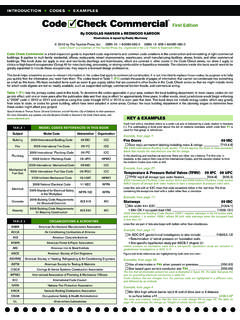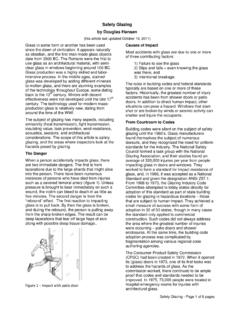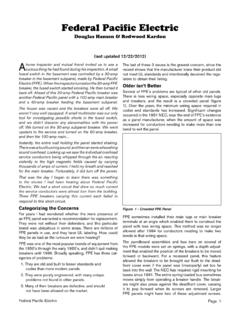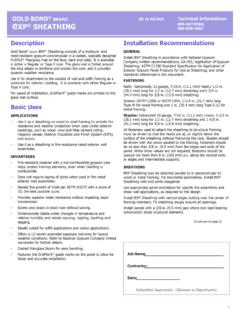Transcription of Code 3Check Building
1 1 BUILDINGINTRODUCTION u KEYCode 3 Check Building Third EditionBY DOUGLAS HANSEN & REDwOOD KARDONI llustrations & Layout: Paddy Morrissey 2011 by The Taunton Press, Inc. ISBN-13: 978-1-60085-329-6 Code Check is a registered trademark of The Taunton Press, Inc., registered in the Patent & Trademark Office. Printed in updates and information related to this book, visit on Chapters 1 through 10 of the 2009 International Residential Code Code Check Building is a condensed guide to the Building portions of the 2009 International Residential Code (IRC) for One- & Two-Family Dwellings. The IRC is the most widely used residential Building code in the United States. Significant code changes are highlighted in the text and summarized in the inside back cover, which means that the book is also applicable in areas using older editions of the IRC.
2 Check with the local Building department to determine which code is used in your area, and for local TO USING THIS BOOKThe line for each code rule starts with a checkbox and ends with an IRC code refer-ence in brackets. Exceptions and lists start with a bullet and also end with the code reference in brackets. Changes to the 2009 code are highlighted by having the refer-ence in a different color and an endnote to the table on the inside back cover. Example from :n Floor or landing min 36in deep on each side of door EXC _____[ ] Balconies <60sq. ft OK for landing to be <36in deep _____[ ]19 These lines give the basic rule that landings at least 36 inches deep are required on each side of a door, and the code reference in the IRC is section (In the IRC, the number is actually We omit the letter R at the beginning to save space and include more information on each line.)
3 The line that follows is an exception to the rule, and the code reference is Exception. This exception is a new code change, and is explained further on the inside back cover as code change # and Figures are referenced in the code text lines in the following way:Example from :n Notching & boring per F30 & T14 _____[ ]This line says that the rules for notching & boring joists are found in section and illus-trated in figure 30, with further explanation in table u ABBREVIATIONSREFERENCE DOCUMENTSThe IRC is part of the suite of codes published by the International Code Council. It is limited to one- and two-family dwellings and townhouses not more than 3 stories above grade. It is a prescriptive document containing rules and instructions.
4 Aspects of a Building that exceed the scope of the IRC are built to the IBC, a more compre-hensive document containing engineering regulations for structural design. It is ac-ceptable to use any of the specific performance-based provisions of the International Codes as an alternative to the prescriptive rules in the American Forest and Paper Association publishes the Wood Frame Con-struction Manual for One- and Two-Family Dwellings (WFCM), which can be used as an alternate to IRC designs for wood framing. The American Iron and Steel Institute (AISI) publishes the Standard for Cold-Formed Steel Framing Prescriptive Method for One- and Two-Family Dwellings (AISI S230), which can be used as an alternative to the American Concrete Institute (ACI) publishes two documents that supple-ment the prescriptive rules of the IRC.
5 These are ACI 318 Building Codes for Struc-tural Concrete and ACI 530 Building Code Requirements for Masonry Truss Plate Institute (TPI) publishes TPI 1 National Design Standard for Metal Plate Connected Wood Truss Construction, which is mandatory for metal-plate-connected truss design. TPI also contributes to BCSI 1-03 Guide to Good Practice for Handling, Installing & Bracing of Metal Plate Connected Wood OF THIS BOOKThis book follows the same basic sequence as the IRC. It begins with the administrative sections in the IRC chapter 1, followed by the planning and nonstructural topics in the IRC chapter 3. The structural sections are arranged from the ground up, beginning with foundations (chapter 4), followed by floors (5), wall construction (6), wall coverings (7), roof-ceiling construction (8), roof assemblies (9), and chimneys and fireplaces (10).
6 ABBREVIATIONS AAMA = American Architectural Manufacturers AssociationACI = American Concrete InstituteAMI = in accordance with manufacturer s instructionsASTM = American Society for Testing & MaterialsBO = Building officialBwL = braced wall lineBwP = braced wall panelcfm = cubic feet per minuteCMU = concrete masonry unitEXC = exception to rule will follow in the next lineFSD = fire separation distanceft = feetGB = gypsum boardhr = hourIBC = International Building CodeICF = insulating concrete formin = inchesL&L = listed and labeledmax = maximummin = minimummph = miles per = on centerPL = property linePT = pressure treatedpsf = pounds per square footpsi = pounds per square inchreq = requirereq d = requiredreq s = requires, requirementsSDC = Seismic Design Categorysq.
7 = square, as in sq. ftw/ = withw/o = withoutwRB = water-resistive barrierwSP = wood structural panel 14 BUILDINGEGRESSS tairs: General 09 IRCn Min width above handrail 36in except spiral stairways F11 _____[ ]n Max handrail projection into stairway 4 in F11 _____[ ]n Min headroom 6ft 8in EXC F11 _____[ ] Floor openings above stair OK to project 4 in into req d headroom at the side of a flight of stairs _____[ ]20n Riser height max 7 in, tread depth min 10in EXC F12 _____[ ] Tread depth min 11in if no nosing projection on treads F12 _____[ ]n Measure rise & run exclusive of carpets, rugs, or runners _____[ ]21n Tallest riser not >3/8in than shortest riser F12 _____[ ]n Deepest tread not >3/8in than shortest F12 _____[ ]n Max 2% slope on treads & landings _____[ ]n Enclosed accessible space below stairs req s min in GB _____[ ]
8 Nosings & Risers 09 IRCn Nosing req d for solid risers w/treads <11in deep F12 _____[ ]n Nosing projection min in, max 1 in F12 _____[ ]n Deepest nosing projection not >3/8in than shortest F12 _____[ ]n Beveling of nosing max in, max nosing radius in _____[ ]n Risers vertical or sloped from tread above max 30 from vertical __[ ]n Open riser treads must prevent passage of 4in sphere EXC _____[ ] Opening between adjacent treads not limited if stair rise 30in _ [ ]Stair width & HeightFIG. 11 Return to wallMin. 1 in. between wall & handrail, max. 4 in. projection from wallMin. 6 ft. 8 in. headroomclearanceLight switch req. at each floor level with 6 or more 36 projection:min. 3 4 in., max. 11 4 projection not >3 8 in. than smallestMax.
9 Radius 9 16 73 4 no nosing and solid risers, tread min. 11 Rise & RunTread min. 10 1215 BUILDINGEGRESS winding Stairs F13 09 IRCn Walkline concentric to curvature of stair & measured 12in from first clear area on narrow side of winder walking surface _____[ ]22n Min tread depth 10in at walkline _____[ ]n Deepest tread not >3/8in than shortest measured at walkline _____[ ]n OK for winder treads to not be within 3/8in of depth of rectangular treads in same flight of stairs _____[ ]23 Walkline is concentric to direction of travel & measured 12 in. from point where foot can be placed on narrow side of stairs. Min. 10 in. tread depth at walkline; deepest tread may not exceed shortest by >3 8 in. Min. 10 in. depth at walklineMin. 6 in.
10 Depth within shaded area12 depth of rectangular treads in same flight as winders is allowed to be different than uniform depth of winders at StairsFIG. 13 Handrails 09 IRCn Req d on at least one side of flights of stairs w/ 4 risers F11,15 ___[ ]n Top 34 38in above line connecting nosings F15 EXC _____[ ] Volute, turnout, or starting easing OK over lowest tread _____[ ] Fitting or bending OK to exceed max height at continuous transition between flights, start of flight, or from handrail to guard F15 _[ ]24n Ends must return to wall or post or safety terminal F11,15 _____[ ]n Min 1 in space between wall and handrail F11 _____[ ]n Handrail continuous from line above top & bottom nosings EXC __[ ] May be interrupted by post at landing _____[ ] Volute, turnout, or starting easing OK over lowest tread F15 __[ ]n Round handrails min 1 in max 2in diameter F14 _____[ ]








